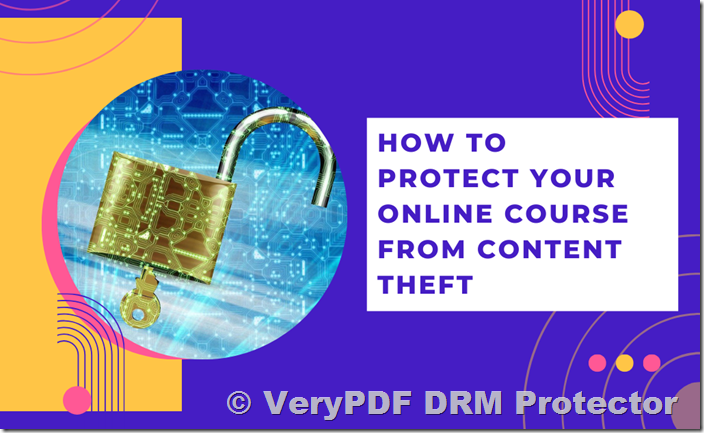E-learning platforms are becoming increasingly popular, with institutions, companies, and individuals relying on online courses and training materials. However, as the demand for e-learning grows, so does the need for secure content protection. One of the most effective ways to protect e-learning content and materials from unauthorized access, theft, and piracy is through Digital Rights Management (DRM) encryption. This article will explore how DRM encryption can help safeguard your e-learning materials and ensure that your intellectual property remains secure.
What is DRM Encryption?
Digital Rights Management (DRM) encryption is a set of technologies used to control how digital content is accessed, distributed, and used. It involves encrypting content to prevent unauthorized users from accessing or modifying it without permission. In the context of e-learning, DRM encryption helps protect course materials, video lectures, PDFs, and other digital resources that are part of an online learning experience.
Key Benefits of DRM Encryption for E-Learning Content
-
Prevent Unauthorized Access and Piracy DRM encryption ensures that only authorized users can access your e-learning content. By implementing encryption, you can restrict access to only those who have purchased or enrolled in a course, making it difficult for unauthorized individuals to share or download the content. This reduces the risk of piracy, ensuring that your educational materials remain protected from illegal distribution.
-
Secure PDF Documents and Interactive Materials Many e-learning materials, such as study guides, textbooks, and course outlines, are often distributed in PDF format. DRM encryption helps prevent unauthorized copying, printing, or editing of these documents. It can also restrict users from taking screenshots or screenshots of sensitive content. This is particularly important when dealing with proprietary learning resources or content that contains confidential information.
-
Control and Track User Access DRM encryption allows e-learning platforms and instructors to set specific permissions for each user, such as restricting access to certain materials based on their progress or subscription level. Additionally, DRM technology can provide detailed tracking, allowing administrators to monitor who has accessed the content, when it was accessed, and for how long. This is crucial for protecting intellectual property and maintaining a secure learning environment.
-
Protect Video Content Video lectures are one of the most valuable types of e-learning content. DRM encryption can prevent users from downloading or redistributing these videos without authorization. By encrypting video files, you can ensure that only authorized individuals can view them, thus protecting the content from being illegally distributed.
-
Enable Secure Cloud-Based Learning With the rise of cloud-based e-learning platforms, DRM encryption ensures that your content remains protected, even when stored and accessed remotely. Cloud storage allows for the centralization of educational resources, making it easier for learners to access content from anywhere. However, DRM encryption ensures that content remains secure in the cloud, protecting it from unauthorized access and ensuring compliance with privacy regulations.
-
Facilitate Licensing and Subscriptions DRM encryption can be configured to allow different levels of access to e-learning content, based on licensing agreements or subscription models. For example, you can offer a free trial version of your course, and after the trial period, the DRM encryption can automatically restrict access to the materials unless the user purchases a full license. This offers an additional layer of protection while ensuring that only paying users have access to premium content.
-
Prevent Content Modification and Tampering DRM encryption protects against unauthorized tampering or alteration of course materials. Whether it’s a PDF document, a video, or any other type of content, DRM ensures that users cannot modify, edit, or manipulate your content in ways that could undermine its educational value. This is especially important when dealing with quizzes, assessments, or certifications, where content integrity is crucial.
How DRM Encryption Works in E-Learning Platforms
DRM encryption in e-learning platforms typically works through a combination of encryption algorithms, digital watermarking, and user authentication mechanisms. Here’s a simple breakdown of how it works:
-
Content Encryption: The e-learning content is encrypted using secure algorithms that scramble the data, making it unreadable without the proper decryption key.
-
Access Control: When a user purchases or enrolls in a course, they receive a decryption key or a secure token that allows them to access the content. This key is often linked to the user’s account or device to ensure that it cannot be shared or misused.
-
Digital Watermarking: A digital watermark can be embedded in the content to track its usage and help identify the source if it is illegally shared. Watermarks can also serve as a deterrent to potential pirates, as they make the content traceable.
-
Monitoring and Reporting: DRM technology can track the user’s activity, providing detailed logs on how, when, and where the content was accessed. This allows administrators to monitor for any unusual activity and take action if necessary.
Conclusion
In conclusion, DRM encryption plays a critical role in protecting e-learning content and materials. By implementing DRM encryption, educational institutions and e-learning platforms can safeguard their intellectual property, prevent unauthorized access, and maintain control over how their content is distributed and used. DRM not only ensures that your content is protected from piracy and theft but also allows for secure licensing, tracking, and monitoring, making it a vital tool for anyone involved in online education. Whether you’re providing video lectures, PDFs, or interactive learning materials, DRM encryption offers the peace of mind that your content will remain secure and protected.
If you’re looking to implement DRM encryption for your e-learning platform, consider a solution like VeryPDF DRM Protector, which offers advanced protection features such as content encryption, access controls, dynamic watermarking, and more to ensure that your e-learning materials stay secure.

